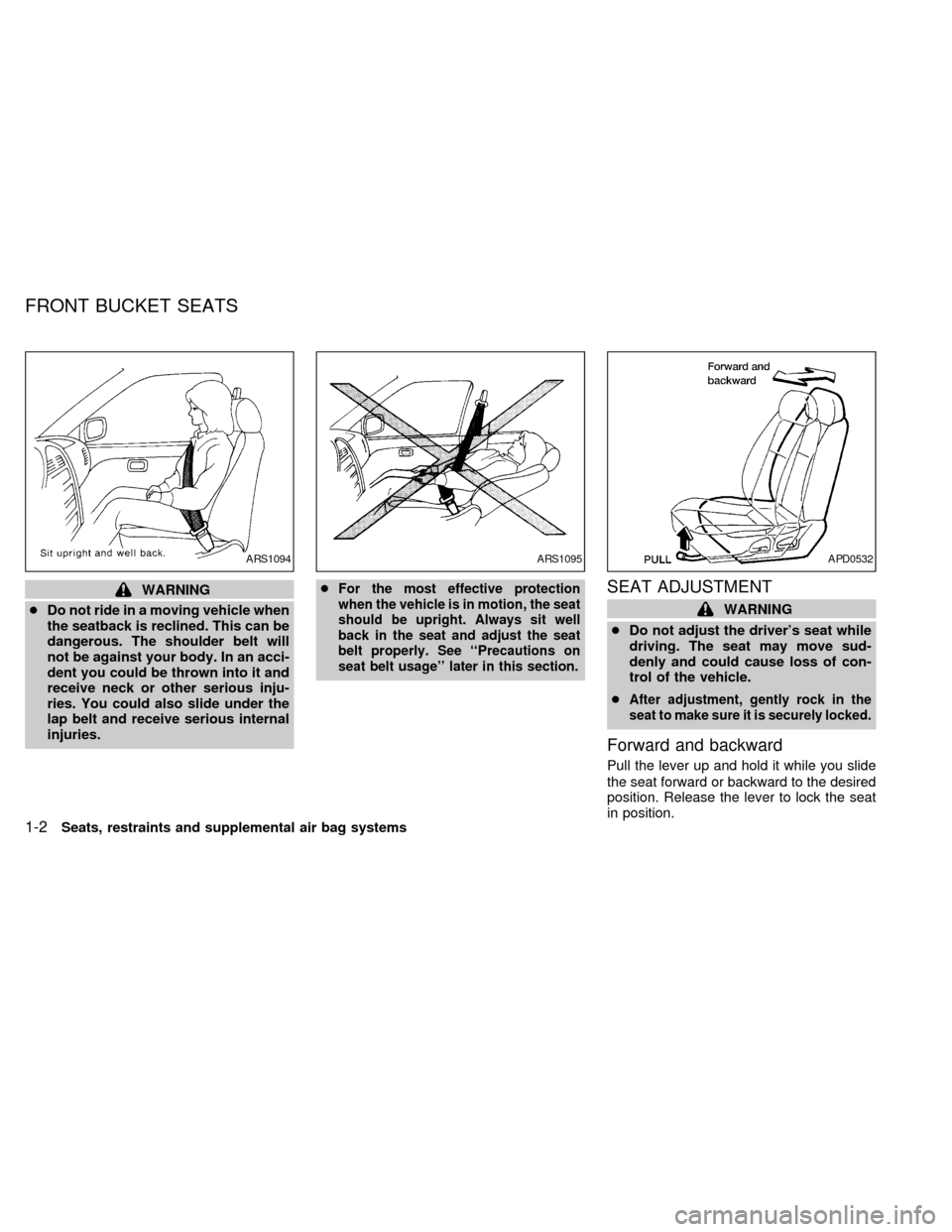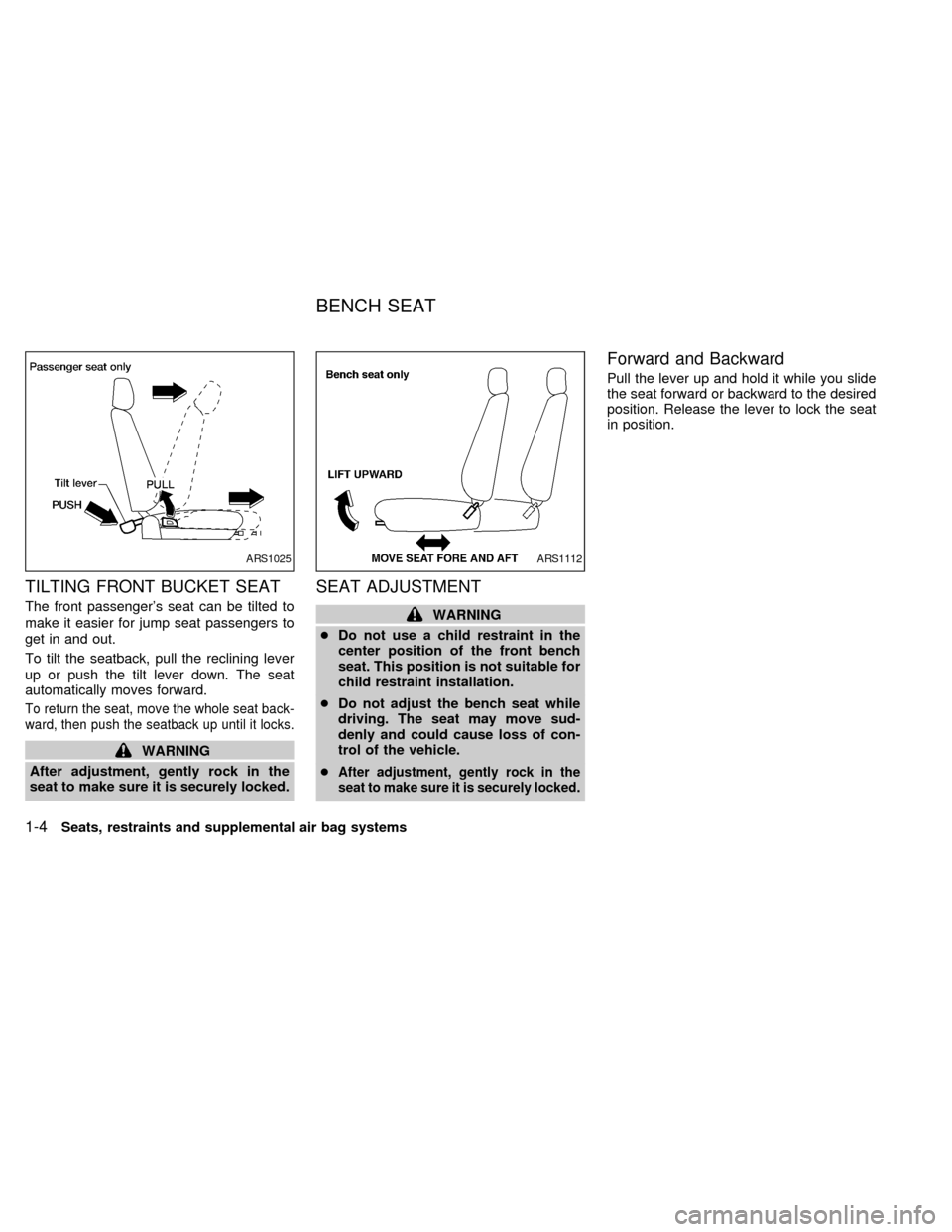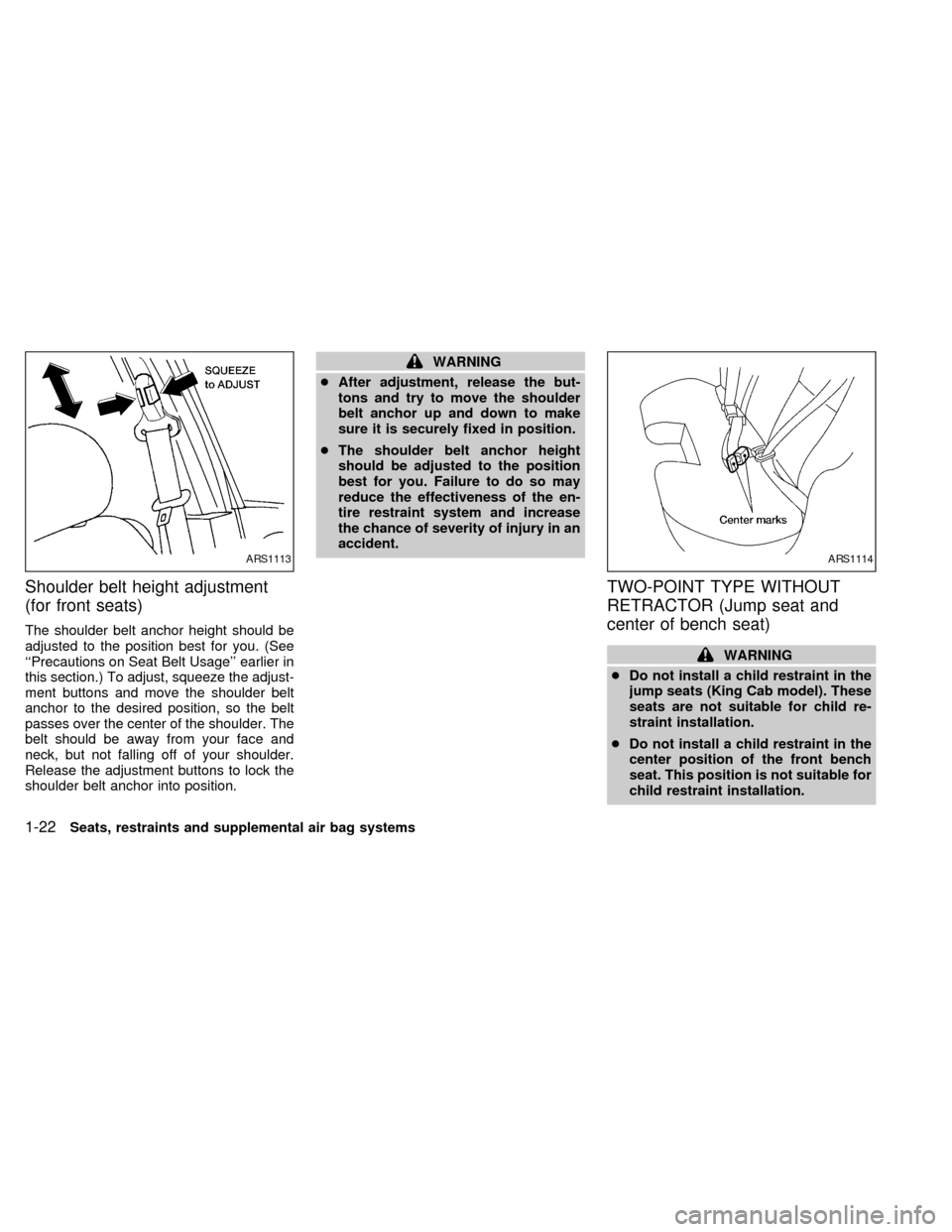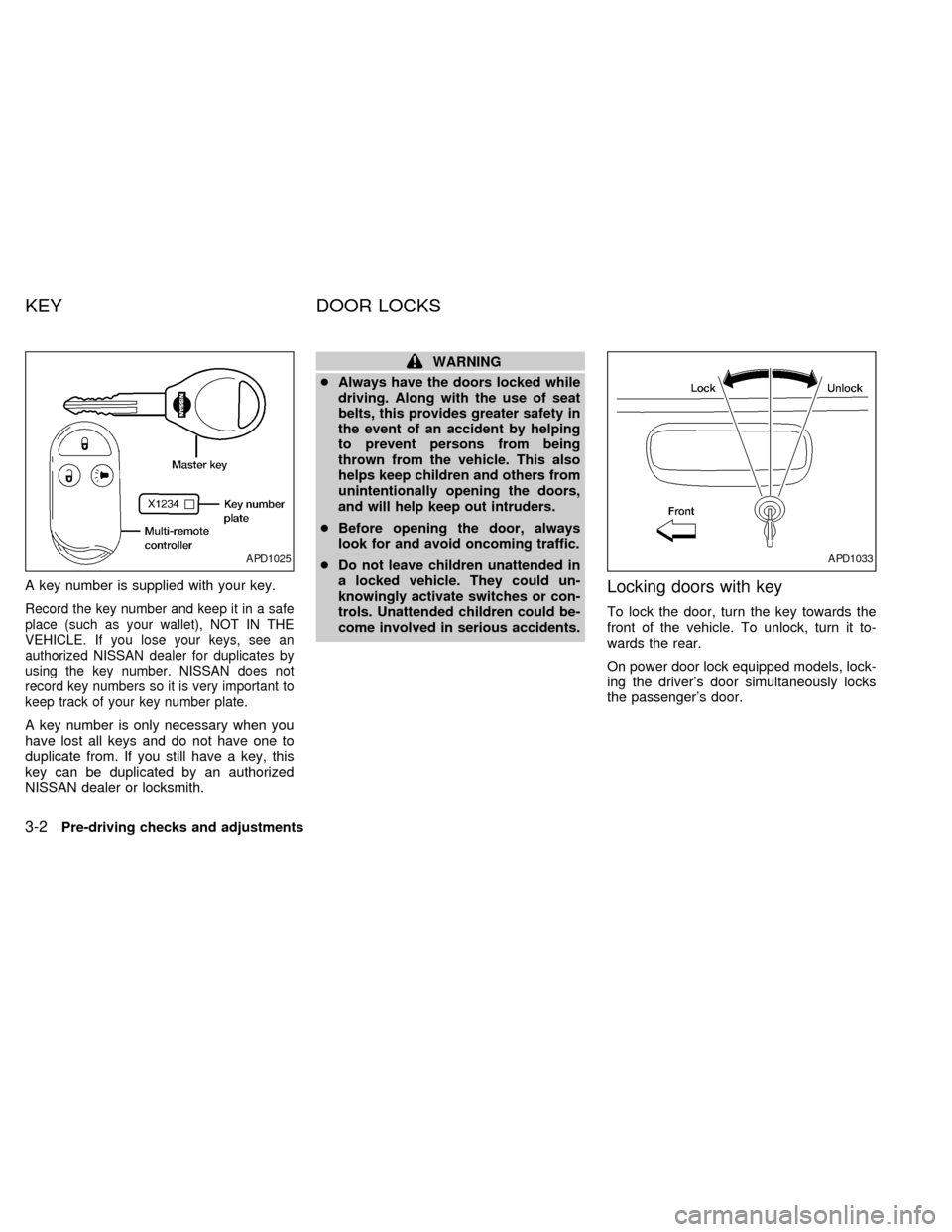Page 6 of 224
Table of
ContentsSeats, restraints and supplemental air bag systems
Instruments and controls
Pre-driving checks and adjustments
Heater, air conditioner and audio systems
Starting and driving
In case of emergency
Appearance and care
Do-it-yourself
Maintenance
Technical and consumer information
Index
1
2
3
4
5
6
7
8
9
10
11
Page 8 of 224

1 Seats, restraints and supplemental air
bag systems
Front bucket seats..................................................1-2
Seat adjustment .....................................................1-2
Head restraints .......................................................1-3
Tilting front bucket seat ..........................................1-4
Bench seat .............................................................1-4
Seat adjustment .....................................................1-4
Tilting bench seat ...................................................1-5
Jump seats .............................................................1-6
Supplemental restraint system (supplemental
air bag system).......................................................1-7
Supplemental air bag system...............................1-10
Passenger supplemental air bag on/off switch
and light. ...............................................................1-12
Warning labels......................................................1-15
Supplemental air bag warning light......................1-15
Seat belts .............................................................1-17Precautions on seat belt usage ...........................1-17
Child safety...........................................................1-18
Pregnant women ..................................................1-19
Injured persons ....................................................1-19
Three-point type with retractor .............................1-20
Two-point type without retractor (jump seat
and center of bench seat) ....................................1-22
Seat belt extenders ..............................................1-25
Seat belt maintenance .........................................1-25
Child restraints .....................................................1-25
Front facing installation on front passenger
seat (three-point type with retractor) ....................1-27
Rear facing installation on front passenger
seat (three-point type with retractor) ....................1-30
Top strap child restraint .......................................1-33
ZX
Page 9 of 224

WARNING
cDo not ride in a moving vehicle when
the seatback is reclined. This can be
dangerous. The shoulder belt will
not be against your body. In an acci-
dent you could be thrown into it and
receive neck or other serious inju-
ries. You could also slide under the
lap belt and receive serious internal
injuries.cFor the most effective protection
when the vehicle is in motion, the seat
should be upright. Always sit well
back in the seat and adjust the seat
belt properly. See ``Precautions on
seat belt usage'' later in this section.SEAT ADJUSTMENT
WARNING
cDo not adjust the driver's seat while
driving. The seat may move sud-
denly and could cause loss of con-
trol of the vehicle.
c
After adjustment, gently rock in the
seat to make sure it is securely locked.
Forward and backward
Pull the lever up and hold it while you slide
the seat forward or backward to the desired
position. Release the lever to lock the seat
in position.
ARS1094ARS1095APD0532
FRONT BUCKET SEATS
1-2Seats, restraints and supplemental air bag systems
ZX
Page 11 of 224

TILTING FRONT BUCKET SEAT
The front passenger's seat can be tilted to
make it easier for jump seat passengers to
get in and out.
To tilt the seatback, pull the reclining lever
up or push the tilt lever down. The seat
automatically moves forward.
To return the seat, move the whole seat back-
ward, then push the seatback up until it locks.
WARNING
After adjustment, gently rock in the
seat to make sure it is securely locked.
SEAT ADJUSTMENT
WARNING
cDo not use a child restraint in the
center position of the front bench
seat. This position is not suitable for
child restraint installation.
cDo not adjust the bench seat while
driving. The seat may move sud-
denly and could cause loss of con-
trol of the vehicle.
c
After adjustment, gently rock in the
seat to make sure it is securely locked.
Forward and Backward
Pull the lever up and hold it while you slide
the seat forward or backward to the desired
position. Release the lever to lock the seat
in position.
ARS1025ARS1112
BENCH SEAT
1-4Seats, restraints and supplemental air bag systems
ZX
Page 12 of 224
TILTING BENCH SEAT
The bench seat can be tilted forward to
make it easier to remove the jacking tools
from the storage area.
To tilt the seatback, push the tilting leverdown, then pull the seatback forward.
WARNING
After adjustment, gently rock in the
seat to make sure it is securely locked.
APD0703
Seats, restraints and supplemental air bag systems1-5
ZX
Page 29 of 224

Shoulder belt height adjustment
(for front seats)
The shoulder belt anchor height should be
adjusted to the position best for you. (See
``Precautions on Seat Belt Usage'' earlier in
this section.) To adjust, squeeze the adjust-
ment buttons and move the shoulder belt
anchor to the desired position, so the belt
passes over the center of the shoulder. The
belt should be away from your face and
neck, but not falling off of your shoulder.
Release the adjustment buttons to lock the
shoulder belt anchor into position.
WARNING
cAfter adjustment, release the but-
tons and try to move the shoulder
belt anchor up and down to make
sure it is securely fixed in position.
cThe shoulder belt anchor height
should be adjusted to the position
best for you. Failure to do so may
reduce the effectiveness of the en-
tire restraint system and increase
the chance of severity of injury in an
accident.
TWO-POINT TYPE WITHOUT
RETRACTOR (Jump seat and
center of bench seat)
WARNING
cDo not install a child restraint in the
jump seats (King Cab model). These
seats are not suitable for child re-
straint installation.
cDo not install a child restraint in the
center position of the front bench
seat. This position is not suitable for
child restraint installation.
ARS1113ARS1114
1-22Seats, restraints and supplemental air bag systems
ZX
Page 67 of 224

A key number is supplied with your key.
Record the key number and keep it in a safe
place (such as your wallet), NOT IN THE
VEHICLE. If you lose your keys, see an
authorized NISSAN dealer for duplicates by
using the key number. NISSAN does not
record key numbers so it is very important to
keep track of your key number plate.
A key number is only necessary when you
have lost all keys and do not have one to
duplicate from. If you still have a key, this
key can be duplicated by an authorized
NISSAN dealer or locksmith.
WARNING
cAlways have the doors locked while
driving. Along with the use of seat
belts, this provides greater safety in
the event of an accident by helping
to prevent persons from being
thrown from the vehicle. This also
helps keep children and others from
unintentionally opening the doors,
and will help keep out intruders.
cBefore opening the door, always
look for and avoid oncoming traffic.
cDo not leave children unattended in
a locked vehicle. They could un-
knowingly activate switches or con-
trols. Unattended children could be-
come involved in serious accidents.
Locking doors with key
To lock the door, turn the key towards the
front of the vehicle. To unlock, turn it to-
wards the rear.
On power door lock equipped models, lock-
ing the driver's door simultaneously locks
the passenger's door.
APD1025APD1033
KEY DOOR LOCKS
3-2Pre-driving checks and adjustments
ZX
Page 76 of 224
To open the tailgate to the lowest position,
lift the tailgate to a 45 degree angle, then
release the support cables.
Do not drive the vehicle with the tailgate
down.
WARNING
cIt is extremely dangerous to ride in a
cargo area inside a vehicle. In a
collision, people riding in these ar-
eas are more likely to be seriously
injured or killed.cDo not allow people to ride in any
area of your vehicle that is not
equipped with seats and seat belts.
cBe sure everyone in your vehicle is
in a seat and using a seat belt
properly.
Removing the tailgate
1. Release the tailgate support cables.
2. Hold the tailgate at a 45 degree angle.
3. Pull the tailgate out from the left side
hinge.
4. Remove the tailgate from the right side
hinge.
CAUTION
The tailgate is heavy. Be careful not to
drop it during removal.
APD1038IC0175
Pre-driving checks and adjustments3-11
ZX